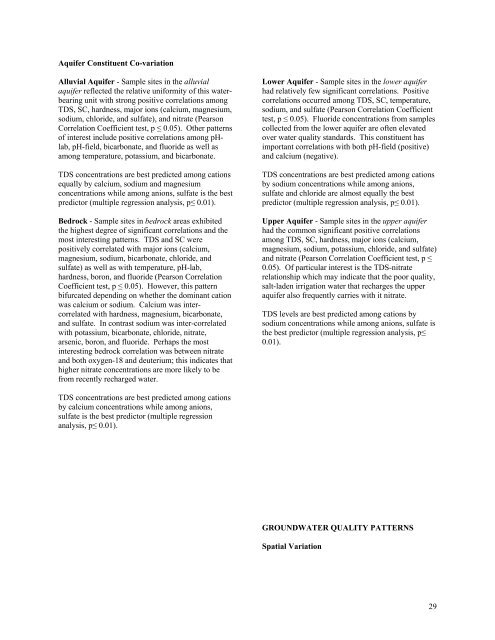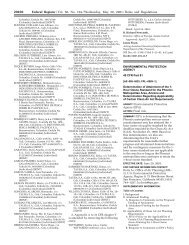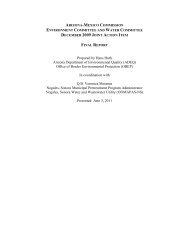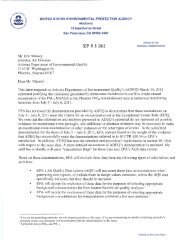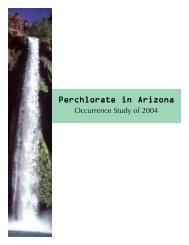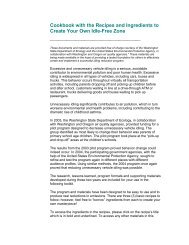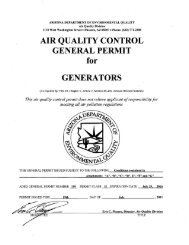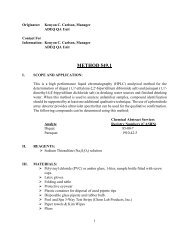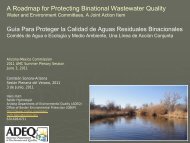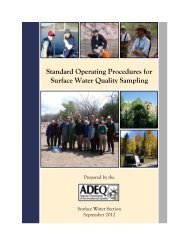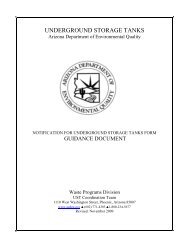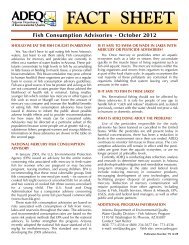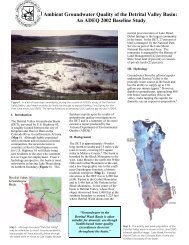San Simon Sub-Basin - Arizona Department of Environmental Quality
San Simon Sub-Basin - Arizona Department of Environmental Quality
San Simon Sub-Basin - Arizona Department of Environmental Quality
You also want an ePaper? Increase the reach of your titles
YUMPU automatically turns print PDFs into web optimized ePapers that Google loves.
Aquifer Constituent Co-variation<br />
Alluvial Aquifer - Sample sites in the alluvial<br />
aquifer reflected the relative uniformity <strong>of</strong> this waterbearing<br />
unit with strong positive correlations among<br />
TDS, SC, hardness, major ions (calcium, magnesium,<br />
sodium, chloride, and sulfate), and nitrate (Pearson<br />
Correlation Coefficient test, p ≤ 0.05). Other patterns<br />
<strong>of</strong> interest include positive correlations among pHlab,<br />
pH-field, bicarbonate, and fluoride as well as<br />
among temperature, potassium, and bicarbonate.<br />
TDS concentrations are best predicted among cations<br />
equally by calcium, sodium and magnesium<br />
concentrations while among anions, sulfate is the best<br />
predictor (multiple regression analysis, p≤ 0.01).<br />
Bedrock - Sample sites in bedrock areas exhibited<br />
the highest degree <strong>of</strong> significant correlations and the<br />
most interesting patterns. TDS and SC were<br />
positively correlated with major ions (calcium,<br />
magnesium, sodium, bicarbonate, chloride, and<br />
sulfate) as well as with temperature, pH-lab,<br />
hardness, boron, and fluoride (Pearson Correlation<br />
Coefficient test, p ≤ 0.05). However, this pattern<br />
bifurcated depending on whether the dominant cation<br />
was calcium or sodium. Calcium was intercorrelated<br />
with hardness, magnesium, bicarbonate,<br />
and sulfate. In contrast sodium was inter-correlated<br />
with potassium, bicarbonate, chloride, nitrate,<br />
arsenic, boron, and fluoride. Perhaps the most<br />
interesting bedrock correlation was between nitrate<br />
and both oxygen-18 and deuterium; this indicates that<br />
higher nitrate concentrations are more likely to be<br />
from recently recharged water.<br />
Lower Aquifer - Sample sites in the lower aquifer<br />
had relatively few significant correlations. Positive<br />
correlations occurred among TDS, SC, temperature,<br />
sodium, and sulfate (Pearson Correlation Coefficient<br />
test, p ≤ 0.05). Fluoride concentrations from samples<br />
collected from the lower aquifer are <strong>of</strong>ten elevated<br />
over water quality standards. This constituent has<br />
important correlations with both pH-field (positive)<br />
and calcium (negative).<br />
TDS concentrations are best predicted among cations<br />
by sodium concentrations while among anions,<br />
sulfate and chloride are almost equally the best<br />
predictor (multiple regression analysis, p≤ 0.01).<br />
Upper Aquifer - Sample sites in the upper aquifer<br />
had the common significant positive correlations<br />
among TDS, SC, hardness, major ions (calcium,<br />
magnesium, sodium, potassium, chloride, and sulfate)<br />
and nitrate (Pearson Correlation Coefficient test, p ≤<br />
0.05). Of particular interest is the TDS-nitrate<br />
relationship which may indicate that the poor quality,<br />
salt-laden irrigation water that recharges the upper<br />
aquifer also frequently carries with it nitrate.<br />
TDS levels are best predicted among cations by<br />
sodium concentrations while among anions, sulfate is<br />
the best predictor (multiple regression analysis, p≤<br />
0.01).<br />
TDS concentrations are best predicted among cations<br />
by calcium concentrations while among anions,<br />
sulfate is the best predictor (multiple regression<br />
analysis, p≤ 0.01).<br />
GROUNDWATER QUALITY PATTERNS<br />
Spatial Variation<br />
29


